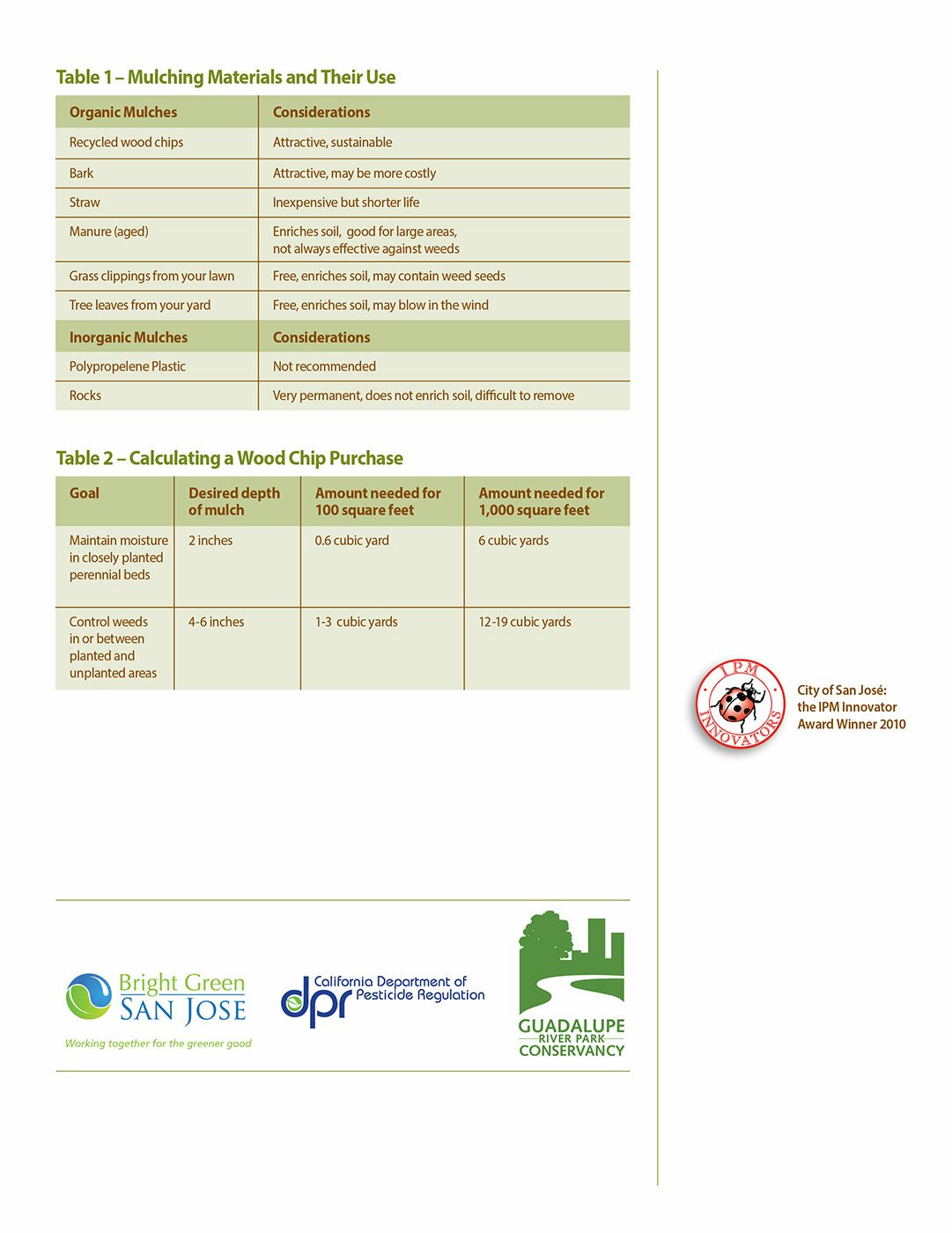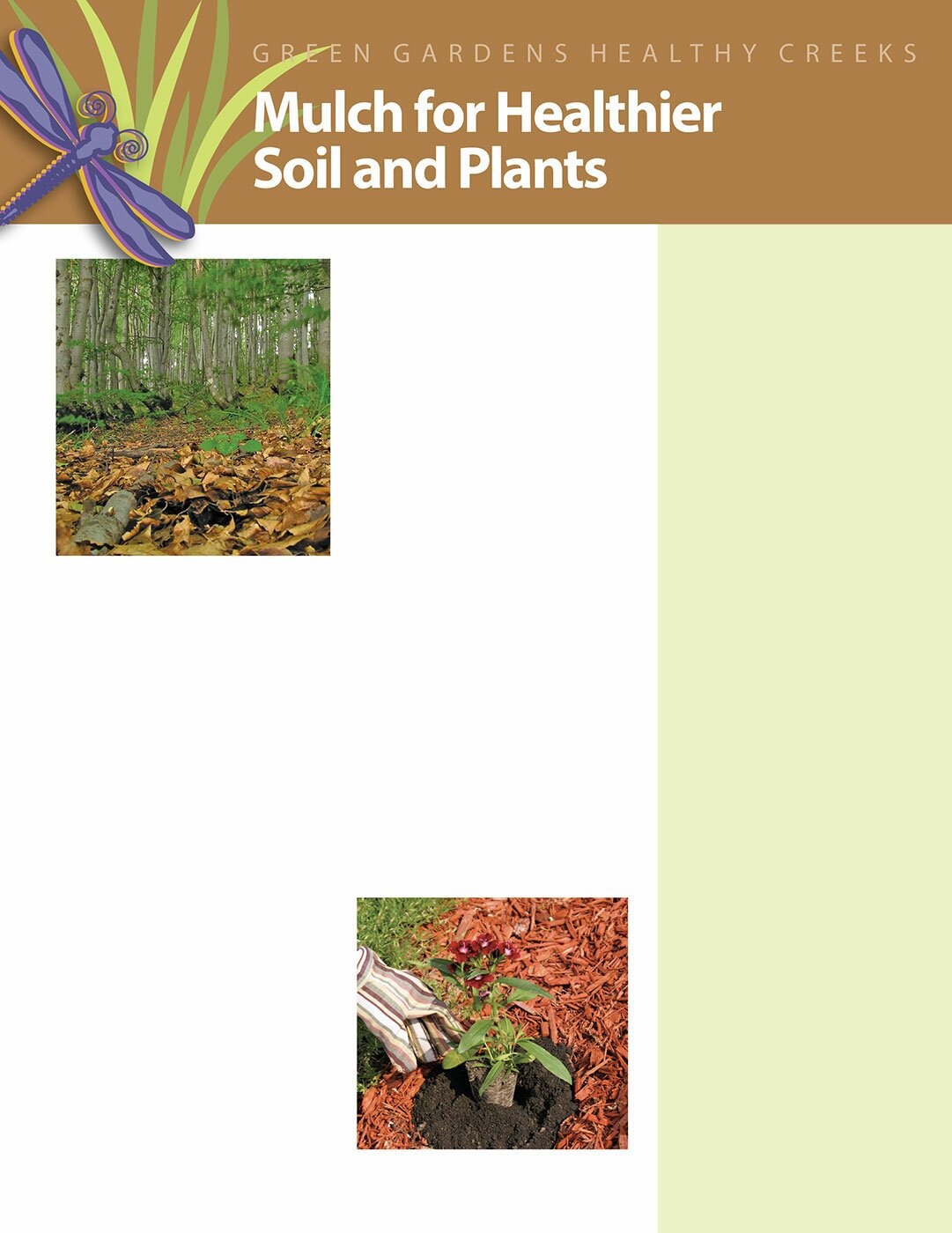In nature, leaves and twigs fall to the ground, first acting as a protective blanket of mulch and eventually becoming nutrient-rich compost as they decompose. Both stages contribute to healthy soil and plants. You can establish this healthy process in your own yard by using mulch.
Using Mulch in Your Sustainable Landscape
Mulch can be any material that can be placed on the surface of the soil to conserve moisture and prevent weeds from growing. Table 1 (over) shows a range of mulching material and considerations for their use. The particular area to be mulched also determines how the mulch should be applied:
On Bare-Soil Pathways and Unplanted Areas
Apply four to six inches of mulch on bare-soil pathways and unplanted areas to prevent compaction and erosion.
Under Trees
To prevent grass and weed growth around the base of trees, apply two to four inches
of wood chip mulch at least two feet out from the trunk. Leaving an open space near the trunk will prevent damage from weed-whackers and lawn mowers.
Around Woody Perennials and Shrubs
Apply two to four inches of wood chip mulch to help maintain soil moisture. Adding more - four to six inches deep - will also help prevent weed growth.
Around Vegetables and in Flower Beds
Apply one to two inches of straw or composted manure; this is best for annual plants because it breaks down quickly.
Recycle Green Waste as Mulch
Let falling leaves remain on the soil as mulch. Leaves can be shredded with a lawn mower and collected in a mower bag to be spread under shrubs. This will keep them in place in mulched areas and speed up their decomposition.
Get into a Mulch Routine!
Eventually, mulch will decompose and weed seeds will blow in and grow. Reapplying a one to two inch layer of mulch every six to twelve months (in fall before the rainy season, and in spring) is the key to preventing weeds from establishing. A fresh layer of mulch will keep your garden looking clean and weed free!
Mulch Brings Benefits
Mulching can provide long-term savings on your landscaping investment. Specifically, mulching:
- Reduces weed growth, and weeds that do come up are easier to pull.
- Saves on watering needs by helping soil retain moisture.
- Helps protect plants from soil-borne plant diseases.
- Decomposes over time into compost to feed the soil food web.
- Promotes soil health by moderating temperature, improving drainage, and preventing erosion and compaction.
Mulching Tips
- Keep mulch six inches away from stems and two feet away from trunks to protect against microorganisms that cause plant diseases.
- Keep mulch 12 inches from building foundations to avoid creating a habitat for pests next to buildings.
- Use borders between lawns and mulched beds to prevent grass from creeping into the mulched area. Border material can be concrete, bricks, recycled plastic strips, or stone; the material should be sunk four to six inches and protrude at least one inch.
Check with producer for mulch quality to make sure the mulch is free of invasive weeds or diseased plants.

Developed by Ecology Action of Santa Cruz consulting with the City of San José IPM Program, 408-945-3000.
Content reviewed by A. Sutherland, Urban IPM Advisor Alameda County, UC Statewide IPM Program.
Funding for this project has been provided in full or in part through a grant awarded by the Department of Pesticide Regulation (DPR). The contents of this document do not necessarily reflect the views and policies of the Department of Pesticide Regulation, nor does mention of trade names or commercial products constitute endorsement or recommendation for use.
Additional Resources
In addition to your local garden supply store, you can buy compost and mulch from:
Zanker Road Resource
Management Ltd.
705 Los Esteros Road
San José, CA 95134
(408) 263-2385
Z-Best Composting Facility
980 CA Hwy 25
Gilroy, CA 95020
(408) 263-2384
Newby Island Resource
Recovery Park
1601 Dixon Landing Road
Milpitas, CA 95035
(408) 432-1234
Mulching tips video
This list in no way implies or conveys that the City of San José Environmental Services Department endorses these suppliers or their products. This list is provided as a courtesy, for informational purposes only, and is not a complete list of suppliers.
Factsheets:
To learn more about compost, plant choices, or other sustainable principles, see the other factsheets in this series.
